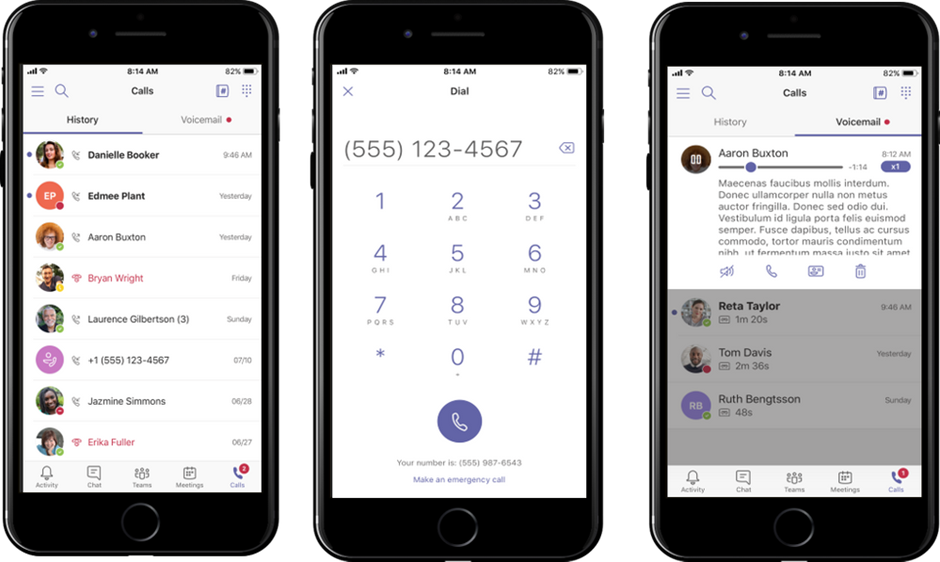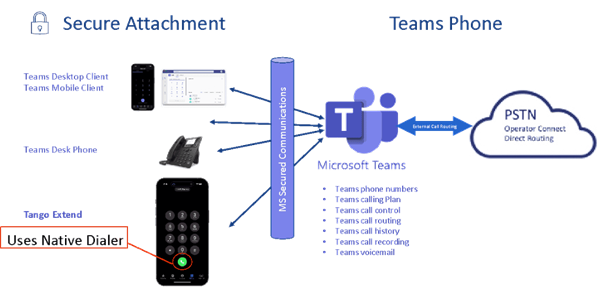Most Microsoft Teams rollouts start with meetings and messaging. But mobile is often where users spend most of their time and where many enterprise voice strategies fall behind.
A Frost & Sullivan study, found that 48% of employees already use mobile phones as their primary business device — a figure projected to hit 53% by 2027.
As mobile becomes the default workspace, IT leaders are asking the same question: How should Microsoft Teams handle voice on mobile?
Microsoft now offers three ways to deliver Teams Phone to smartphones: the Teams mobile app, Teams Phone Mobile, and Tango Extend. Each routes calls differently — through the app, the carrier, or an eSIM.
This guide compares the three options for Teams Phone mobile. You’ll see how they differ, what they support, and where each options fits best in a real enterprise voice strategy.
Option 1 - Microsoft Teams Mobile App on iPhone and Android

The Microsoft Teams Mobile App is where most organizations start. It’s available on both iOS and Android and mirrors the core Teams experience: meetings, chat, presence, and voice — all inside a single interface.
When paired with Microsoft Calling Plans, Operator Connect, or Direct Routing, the Teams app doubles as a softphone. Users can make and receive PSTN calls directly from the app, just like on desktop.
The experience is consistent. Presence syncs across devices. Voicemail and call history stay unified. And IT has nothing new to deploy — users simply sign in with their Microsoft 365 credentials.
Supported platforms: iOS and Android
Works with: Microsoft Calling Plan, Operator Connect, Direct Routing
Key benefits:
- Unified Teams experience across devices
- No additional licensing costs
- Quiet hours and notification control
- Works anywhere with data or Wi-Fi
Downsides: The Teams mobile app depends entirely on data connectivity. Move between Wi-Fi and cellular, and calls can lag or drop. The app also can’t function offline — a limitation for field teams or regions with weak coverage.
It’s also not built for regulated industries that need network-level compliance recording. And for users who live in their phone’s native dialer, the constant app switching can break flow.
That’s why Microsoft built Teams Phone Mobile — to move Teams voice deeper into the mobile network itself.
Option 2 - Teams Phone Mobile
Teams Phone Mobile is Microsoft’s operator-integrated version of Teams Phone. Instead of routing calls through the app, it connects your Teams identity directly to the mobile network.
That means one number, one voicemail, and one call history across both the native dialer and the Teams client. Employees can make or receive calls through either — the network treats them as the same endpoint.
How it works:
The enterprise partners with a participating carrier that supports Teams Phone Mobile. The carrier links the SIM to the user’s Teams account, allowing calls to traverse the operator network with Teams features intact.
Ideal for: regulated industries and enterprise-issued mobile fleets.
Availability: limited to select operators and regions.
Key benefits:
- One number across Teams and mobile
- Unified voicemail and presence
- Network-level compliance recording
- Seamless call uplift between dialer and app
- Simplified user experience — no dual provisioning
Downsides: Teams Phone Mobile requires specific carrier support, and coverage is still expanding. It’s not BYOD-friendly — users need company-issued devices and managed mobile plans. Global rollouts can also get complex if your organization spans regions without supported operators.
For companies that want flexibility — support for personal devices, multiple regions, and offline calling — Tango Extend bridges that gap.
Option 3 - Tango Extend, bring your Teams Phone number to your mobile via eSIM

Tango Extend offers a new route to mobile Teams Calling. Instead of relying on Microsoft’s carrier partnerships or the Teams app itself, it uses an eSIM linked to Teams through the SIP Gateway.
The result: employees can make and receive Teams Phone calls through their native mobile dialer — no app, no data connection required.
Tango Extend works with Pure IP’s Operator Connect or Direct Routing via our Mobile Connect product, so enterprises retain full control of their PSTN integration. It’s designed for hybrid and BYOD environments, giving users the freedom to use personal phones without compromising security or compliance.
Works with: Operator Connect or Direct Routing
Compatible devices: eSIM-enabled iOS and Android phones
Ideal for: Hybrid, frontline, and BYOD workforces
Key benefits:
- Works offline — no app or data dependency
- Uses native mobile dialer
- Unified presence and voicemail in Teams
- Supports compliance recording
- Fully BYOD-friendly
Unlike Teams Phone Mobile, Tango Extend isn’t limited by carrier coverage. It’s operator-independent and works in any region where Teams SIP Gateway and Operator Connect or Direct Routing are supported.
For global organizations, that independence matters. Tango Extend delivers the control of Teams with the reach of BYOD mobility — a balance few enterprise solutions achieve.
|
Feature |
Teams Mobile App |
Teams Phone Mobile |
Tango Extend |
|
Uses Microsoft Teams app |
✅ Yes |
✅ Optional |
❌ No |
|
Native mobile dialer integration |
❌ No |
✅ Yes |
✅ Yes |
|
Works offline (no data required) |
❌ No |
✅ Yes |
✅ Yes |
|
Requires specific mobile operator |
❌ No |
✅ Yes |
❌ No |
|
BYOD-friendly |
✅ Yes |
❌ No |
✅ Yes |
|
Compliance recording supported |
⚙️ Limited |
✅ Yes |
✅ Yes |
|
Works with Operator Connect / Direct Routing |
✅ Yes |
✅ Operator only |
✅ Yes |
|
Requires eSIM |
❌ No |
❌ No |
✅ Yes |
|
Unified voicemail and presence |
✅ Yes |
✅ Yes |
✅ Yes |
|
Ideal for |
Remote workers |
Enterprise fleets |
BYOD/hybrid users |
Which Microsoft Teams mobile option fits your workforce?
The right Teams Phone solution depends on how your employees connect.
- BYOD or hybrid users: Tango Extend provides the best balance of control and flexibility. It enables Teams Phone on personal devices without installing the app or issuing new hardware.
- Universal access and simplicity: The Teams Mobile App is ideal for knowledge workers who spend most of their time online. It’s cost-efficient and easy to deploy.
- Enterprise-issued mobile fleets: Teams Phone Mobile is purpose-built. It integrates directly with mobile operators, delivering seamless compliance recording and network-native performance.
Most enterprises will mix these. Corporate-issued phones might use Teams Phone Mobile; contractors and hybrid staff might use Tango Extend; and office users can rely on the standard Teams app. The key is alignment — one unified system, tailored by role and region.
Need help choosing a Microsoft Teams Mobile solution?
Enterprise mobile voice doesn’t just mean giving employees an app—it means giving them a number that moves with them, no matter where they are. Pure IP’s Mobile Connect, powered by Tango Extend, enables businesses to extend Teams to smartphones - native dialer, no extra app, built into your global voice network.
From frontline staff to remote teams, it’s mobile-first calling with unified presence, simplified compliance, and full Teams integration.
Talk to our voice experts and make every user mobile with one number, one platform, one service >>



